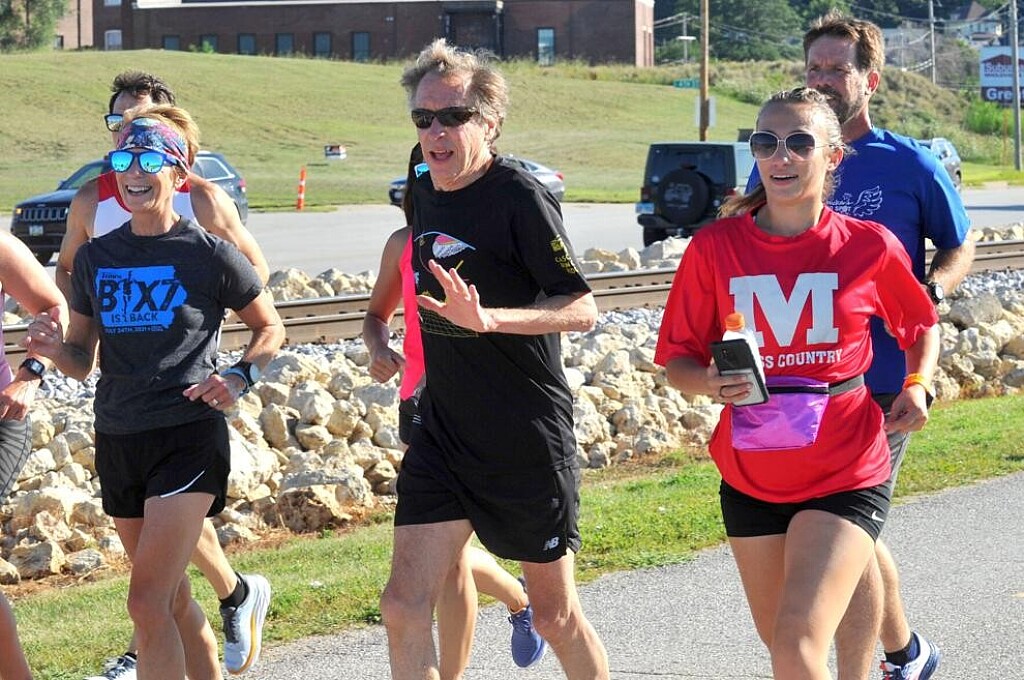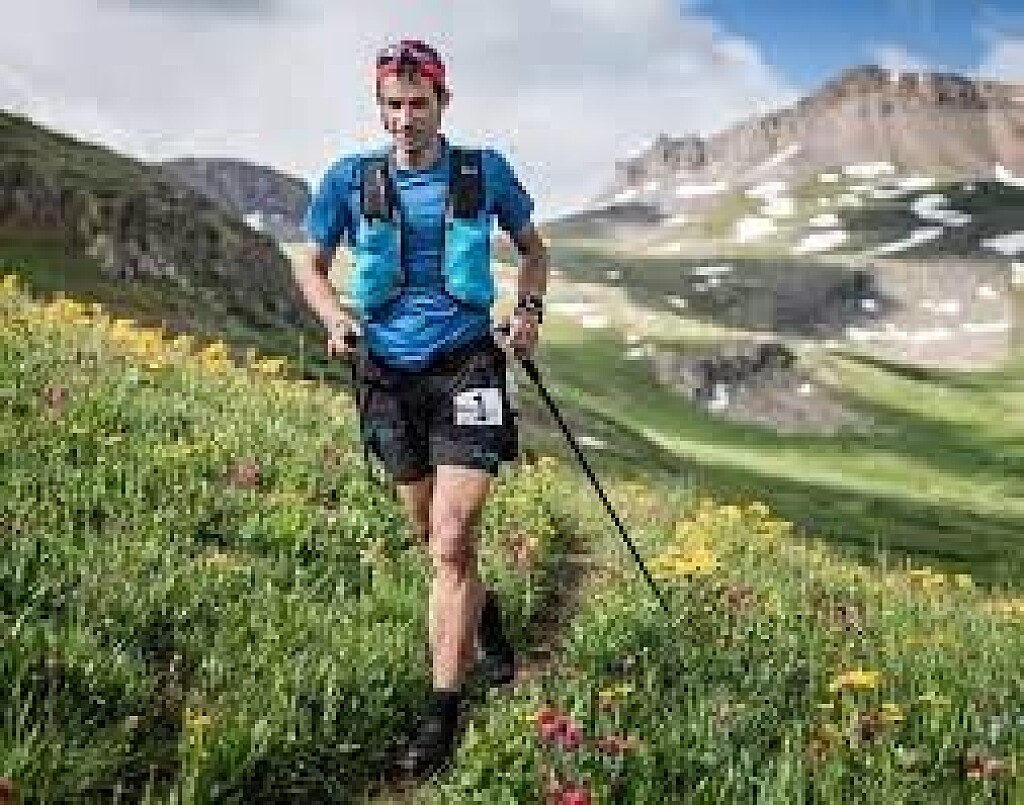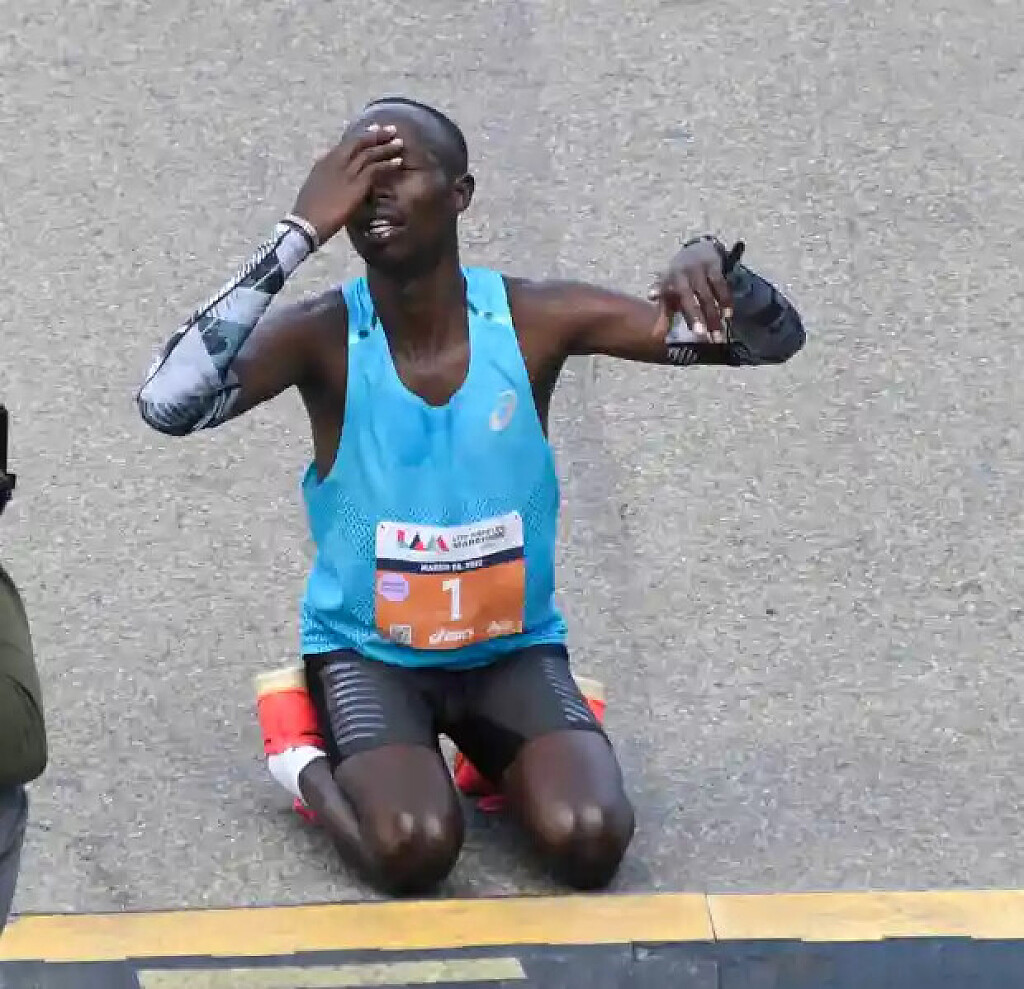Running News Daily
Top Ten Stories of the Week
7/22/2023
These are the top ten stories based on views over the last week.
When Will Eliud Kipchoge Slow Down?
What we can learn from the world’s greatest distance runner of all-time while he’s still in his prime
Eliud Kipchoge has expanded the universe of what’s humanly possible in the marathon, and he will forever remain a legend in the sport of long-distance running.
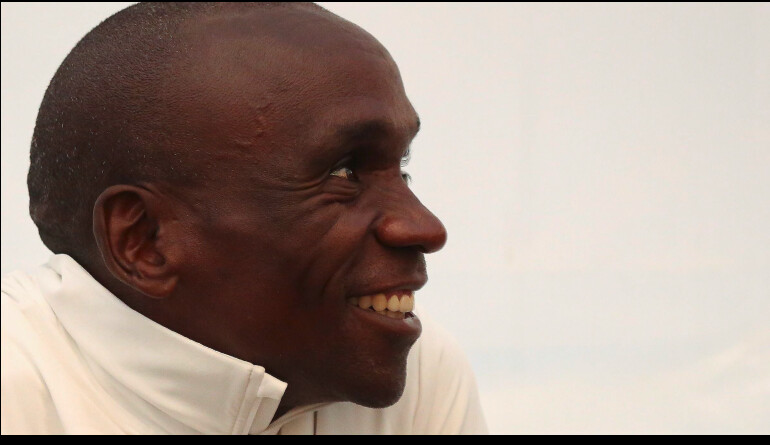
Not only for himself, but especially for those who have come after him. That includes everyone, both elite and recreational runners, who are preparing a marathon this fall or some distant point in the future. His current 2:01:09 world record and his barrier-breaking 1:59:40 time-trial effort in 2019 are legendary feats, both for the current generation of runners and for all time.
The 38-year-old Kenyan marathoner is a once-in-a-lifetime athlete, but time waits for no one, and especially not a long-distance runner. Like all elite athletes, his time at the top is limited, but fortunately, there is still time to immerse in the inspirational examples he’s providing.
Kipchoge recently announced he’ll return to the Berlin Marathon on September 24, where, last year, he won the race for the fourth time and lowered the world record for the second time. It is most likely what will be the beginning of a grand denouement as he goes for another gold medal at the 2024 Olympics next summer in Paris.
Given that he won his first global medal in the City of Light—when, at the age of 18, he outran Moroccan legend Hicham El Guerrouj and Ethiopian legend-in-the-making Kenenisa Bekele to win the 5,000-meter run at the 2003 world championships—it would certainly be one of the greatest stories ever told if he could win the Olympic marathon there next year when he’s nearly 40.
Certainly he’ll run a few more races after the Olympics—and maybe through the 2028 Olympics in Los Angeles—but, realistically, it is the start of a farewell tour for a runner who will never be forgotten.
Don’t get me wrong: I’m not at all writing Kipchoge off. In fact, I am excited to see him run in Berlin and can’t wait to watch next year’s Olympic marathon unfold. But just as we’ve watched Michael Jordan, Tiger Woods, Serena Williams, Shalane Flanagan, Usain Bolt, Allyson Felix, and other elite athletes succumb to the sunsetting of their peak performance level, so too will Kipchoge eventually suffer the same fate.
What I’m saying here is that we still have time to watch and appreciate Kipchoge eloquently working his magic and continue to be inspired in our own running and other pursuits in life. Remember how we marveled at Michael Jordan’s greatest in “The Last Dance” more than 20 years after his heyday? This is the start of the last dance for Kipchoge, who, like Jordan, is much, much more than a generational talent; he’s an all-time great whose legacy will transcend time.
Running has seen many extraordinary stars in the past 50 years who have become iconic figures— Frank Shorter, Joan Benoit Samuelson, Ted Corbitt, Carl Lewis, Steve Jones, Paul Tergat, Catherine Ndereba, Paula Radcliffe, Haile Gebrselassie, Kenenisa Bekele, Mary Keitany, Brigid Kosgei, and Kilian Jornet, to name a few—but none have come close to the body of work and global influence of Kipchoge.
Not only is Kipchoge one of the first African athletes to become a household name and truly command a global audience, but he’s done more than other running champions because of he’s been able to take advantage of this advanced age of digital media to deliberately push positive messages and inspiring content to anyone who is willing to receive it.
Kipchoge has won two Olympic gold medals, set two world records, and won 17 of the 19 marathons he entered, but he’s so much less about the stats and bling and more sharing—to runners and non-runners alike—that “no human is limited” and also that, despite our differences, we’re all human beings faced with a lot of the same challenges in life and, ultimately, hard work and kindness are what put us on the path to success.
How can an average runner who works a nine-to-five job and juggles dozens of other things in daily life be inspired by an elite aerobic machine like Kipchoge?
He is supremely talented, no doubt, but many elite runners have a similar aerobic capacity to allow them to compete on the world stage. What Kipchoge uniquely possesses—and why he’s become the greatest of all-time—is the awareness and ability to be relentless in his pursuit of excellence, and the presence and good will of how beneficial it is to share it.
If you haven’t been following Kipchoge or heard him speak at press conferences or sponsor events, he’s full of genuine wisdom and encouragement that can inspire you in your own running or challenging situation in life. His words come across much more powerfully than most other elite athletes or run-of-the-mill social media influencers, not only because he’s achieved at a higher level than anyone ever has, but because of his genuine interest in sharing the notion that it’s the simplest values—discipline, hard work, consistency, and selflessness—that make the difference in any endeavor.
This is not a suggestion to idolize Kipchoge, but instead to apply his wisdom and determination into the things that challenge you.
“If you want to break through, your mind should be able to control your body. Your mind should be a part of your fitness.”
“Only the disciplined ones in life are free. If you are undisciplined, you are a slave to your moods and your passions.”
“If you believe in something and put it in your mind and heart, it can be realized.”
“The best time to plant a tree was 25 years ago. The second-best time to plant a tree is today.”
Those are among the many simple messages that Kipchoge has lived by, but he also openly professess to giving himself grace to take time for mental and physical rest and recovery. It’s a simple recipe to follow, if you’re chasing your first or fastest marathon, or any tall task in life.
Kipchoge seems to defy age, but his sixth-place finish in the Boston Marathon in April proved he’s human. As much as it was painful to watch him falter, it was oddly refreshing and relatable to see him be something less than exceptional, and especially now that he’s tuning up for Berlin. He has nothing left to prove—to himself, to runners, to the world—but he’s bound to keep doing so just by following the same simple, undaunted regimen he always has.
There will be other young runners who will rise and run faster than Kipchoge and probably very soon. Fellow Kenyan Kelvin Kiptum—who has run 2:01:53 (Valencia) and 2:01:25 (London) in his first two marathons since December—seems to be next in line for Kipchoge’s throne of the world’s greatest runner. But even after that happens, Kipchoge’s name will go down in history alongside the likes of Paavo Nurmi, Abebe Bikila, Emil Zátopek, Grete Waitz, Shorter and Samuelson because of how he changed running and how he gave us a lens to view running without limits.
Berlin is definitely not the end of Kipchoge’s amazing career as the world’s greatest long-distance runner. I fully expect him to win again in an unfathomable time. But the sunset is imminent and, no matter if you are or have ever been an aspiring elite athlete at any level, a committed recreational runner, or just an occasional jogger trying to reap the fruits of consistent exercise, his example is still very tangible and something to behold.
(07/16/23) Views: 539Outside Online
Bill Rodgers is set to run his 43rd Quad-City Times Bix 7
In 1978, Bill Rodgers entered 30 road races and amazingly, astonishingly, he won 27 of them.
Over the course of his running career, he won 22 marathons, all during a thoroughly incredible 10-year period from 1974 to 1983.
He doesn’t win anything anymore, not even in his age group, but the 75-year-old Boston resident is still running, and he will be coming back to run the Quad-City Times Bix 7 for the 43rd time on July 29.

Rodgers said he thought he had done the Falmouth Road Race on Cape Cod about 35 times and the Cherry Blossom 10-miler in Washington, D.C., perhaps 30 times.
He never has entered any race as frequently as he has the Quad-City Times Bix 7, which is holding its 49th event this year.
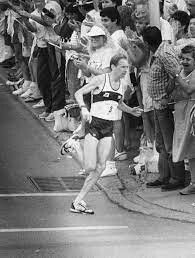
“And the Bix is probably the most challenging of them all,’’ Rodgers said. “But it’s a race I remember so well from that first time in 1980. I was still young and I could duke it out and I could race. Now I just try to hang on.’’
A man who once logged hundreds of miles in training each week now jogs 25 to 30 miles a week. He has done about 10 races this year, including Cherry Blossom. He said he now just went back to some of the old events he did during his heyday.
“But I’m back in the pack,’’ he said. “I’m way back in the pack because I’m 75 years old. It’s like a whole different thing. My strength used to be that I was a marathoner and I could do high mileage. I was a high-mileage runner. I wasn’t as quick as some runners, but I could do the mileage.’’
Not anymore. During the COVID-19 pandemic, Rodgers had a chance to sift through almost 50 years of running logs and he calculated that he has done more than 1,500 races and run at least 190,000 miles in his lifetime.
Most automobiles don’t last that long. And Rodgers hasn’t had the benefit of having a change of tires or periodic oil changes.
His body is feeling the effects of all that mileage. When he enters races now, he frequently finds himself trailing runners of a similar age who have fewer miles on their personal odometers.
“What I’m seeing is I see a lot of these runners who are in their 60s and 70s and they’re all ahead of me, but they just started running pretty recently or something,’’ he said.
He steps up to a new age group this year but doesn’t figure on being a contender to win it. The Quad-City Times Bix 7 course record for men ages 75-79 is 54 minutes, 58 seconds. Rodgers’ finishing time a year ago was 1:08:43.
Despite that, he still enjoys running.
“Now when I do 30 miles a week, I feel like when I was doing 100 miles a week,’’ he said. “I feel good, relatively speaking. No complaints with regards to running. I think it’s a great way to live.’’
Rodgers won the Quad-City Times Bix 7 the first two times he came here, in 1980 and 1981, and finished in the top 10 on seven occasions.
However, he is remembered almost as much for other years.
In 1995, he paused as he was coming down Kirkwood Boulevard to catch women’s leader Olga Appell just as she collapsed from heat exhaustion. He made sure that Appell received medical attention before jumping back into the race.
(07/14/23) Views: 129Kilian Jornet confirms UTMB plan with entry into Eiger Ultra Trail
Kilian Jornet has confirmed he plans to be in Chamonix at the end of August to defend his UTMB title.
And he will race at this weekend’s Eiger Ultra Trail with the aim of securing the single running stone he needs to qualify for UTMB.
Return from Himalayas
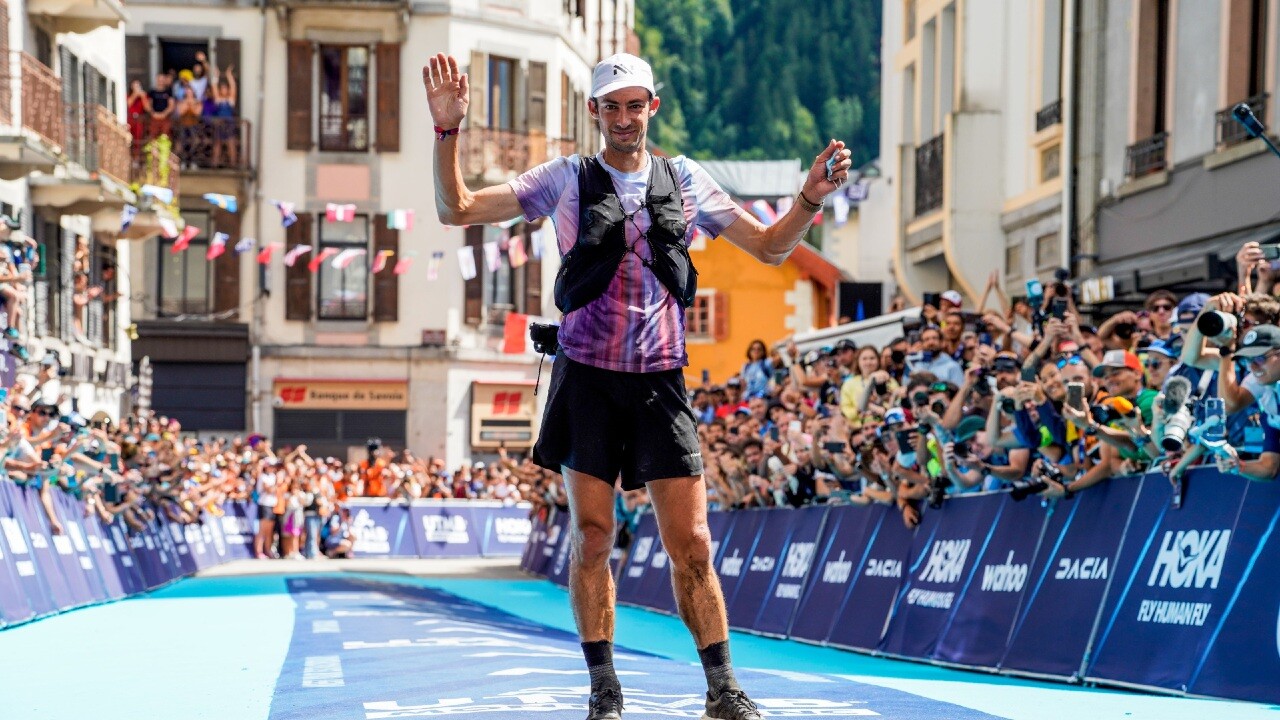
Kilian Jornet is only recently back from a trip to the Himalayas, a trip that saw him survive an avalanche that carried him for 50 metres during a solo attempt on the West Ridge of Everest, and the legendary trail runner and mountaineer has told his Instagram followers that he wanted to be sure he was fully recovered.
”I wanted to see how I was feeling, how I was in my body [after the trip to the Himalayas],” he said.
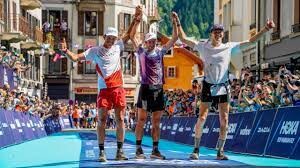
‘’I have mentioned I wanted to do some long distance at the end of the season and actually I am kind of looking like I would like to do UTMB.
‘‘But I need to classify first and I need to have some points so I will try to get them this weekend at Eiger and see if I can be at Chamonix at the end of August.’’
Eiger E16 Pleasure Trail
Jornet will be taking on the E16 Pleasure Trail race on Saturday – a 16k race that is described by the UTMB as ‘perfect for short distance specialists, and for those wishing to enjoy a shorter trail at their leisure.’
Although that race may not be the most likely to feature a runner of Jornet’s calibre, as one of the top-three UTMB finishers last year he has a priority for registration for this year’s event, but he must have at least one running stone and he has chosen Eiger to achieve it.
Last year’s UTMB saw Jornet at his very best as he took his fourth race victory, set a new course record and became the first person to cover the famous course in under 20 hours.
When Jornet announced his 2023 schedule earlier in the year, the only defined race was a return to Sierre-Zinal on August 12th – a race he’s won nine times, setting the course record of 2:25:36 in 2019.
Alongside a ‘trip to the Himalayas’ Jornet said he was considering a ‘Long-distance project/race’ later in the season. That race now looks most likely to be UTMB.
(07/14/23) Views: 124Chris Buckley
John Korir eyes Chicago Marathon after second place at Boilermaker 15km race
Two times Los Angeles Marathon champion John Korir has confirmed participation in the Chicago Marathon set for October 8 in the United States of America (USA).
The younger brother to former Boston Marathon champion Wesley Korir will be seeking his maiden Chicago Marathon win after finishing third last year in 2:05.01, behind champion compatriot Benson Kipruto (2:04.24) and Ethiopia's Seif Tura, who placed second in 2:04.49. Bernard Koech (2:07.01) and Ethiopia's Shifera Tamiru at 2:07.53 completed the top five places in last year's event.
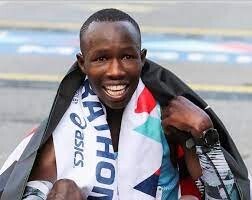
Korir is fresh from finishing second at the Boilermaker 15km road race behind Ethiopian Jemal Yimer last Sunday.
“I was using the Sunday race as part of my training ahead of the Chicago Marathon. Last year, Chicago Marathon was too tough but I want to try my luck this year,” said Korir.
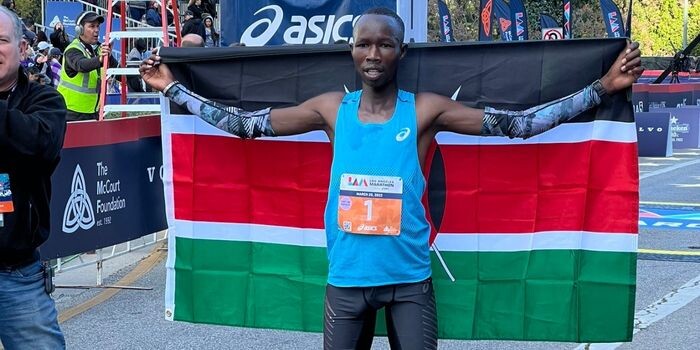
At Bolmaker’s race, Korir said he lost the title in the last kick to finish second in 42:13 behind Yimer (42:06). Kenya’s Charles Langat completed the podium in 42:28.
“He beat me in the last stretch of the race after I miscalculated. However, I thank God for the second position considering the event was very competitive,” he said.
“I normally run two marathons a year plus a few short races as built-up for the World Marathon Majors across the world. Races in the USA have always been my priority,” he added.
Korir said his aim is to once again finish on the podium but a win but if victory comes his way it will be a bonus.
Korir has been out of competition since finishing ninth in 2:1004 in a race won by compatriot Benson Kipruto in the Boston Marathon last April.
“Before heading to Chicago, he will be competing at the Falmouth 12km race on August 20.
In women's cadre, Kenya’s Jesca Chelangat won the Boilermakers 15km after timing 47:31. She was followed by Sarah Naibei (48:45) and Cynthia Limo (48:50).
Chelangat broke the course record set by Edna Kiplagat 13 years ago by 24 seconds. Kiplagat, who was part of the race, placed fourth in 49:10.
(07/14/23) Views: 111Emmanuel Sabuni
Stuck indoors? Some running drills to boost fitness
Some days you just don’t want to go outside. While we know running in adverse conditions can be a good mental-strength builder, even the most hardcore runners occasionally don’t want to tackle the rain/lightning/extreme heat or whatever is happening out the door. No access to a treadmill? No problem–here are some easy ways to give your fitness a boost on those rare times you just want to stay in.
Clear some space and grab your shoes (or not, these exercises all work great in bare feet) and get ready to feel a burn.

The 100-up drill
If you only have a few minutes, 100-ups are the way to go. Christopher McDougall, author of the bestselling Born to Run and Born to Run 2, swears by this exercise as a way to improve and polish your running technique. Best performed in bare feet, you can also fit it in before or in the middle of your regular run to spice things up.

Stand up tall, core engaged, shoulders back, and feet hip-width apart. Bend elbows at 90 degrees into your natural running arm swing position.
Drive your right knee up to hip height while simultaneously driving your left arm forward and up and right arm back in an arm swing, just as if you were running.
Return your foot to the starting position, landing on the ball of your foot directly underneath you. Repeat on the alternate side for 100 repetitions, 50 per side. Start slow, but feel free to increase your pace once you’ve got the hang of it.
Skipping rope
Get your heart rate soaring by jumping rope in place. Skipping is an effective cardio exercise that improves cardiorespiratory health, tones muscles, strengthens bones and boosts flexibility. You’ll feel like you’ve been sprinting and are also boosting your co-ordination, focus and body awareness. Try a 10-minute skipping workout to get started.
Burpees, burpees, burpees
You either love them or hate them–but it’s hard to ignore how effective burpees are. Burpees use a whole set of movements to target major muscle groups, including legs and hips, glutes, core, arms, chest and shoulders. While you hop, squat and push-up, you’ll burn as many calories as you would running, while getting an overall workout.
Begin in a squat position with knees bent, back straight, and feet shoulder-width apart.
Lower your hands to the floor in front of you, just inside your feet. With your weight on your hands, kick (or step) your feet back, so you’re on hands and toes (or knees) in a pushup position.
Keeping your body straight from head to heels (or head to knees), do one pushup. Drop your knees to the ground to modify, if keeping them lifted is too intense.
Jump or step your feet back to their starting position. Stand and reach your arms over your head, then jump into the air, landing where you started. As soon as you land with your knees bent, get back into a squat position and do another repetition.
The sky is the limit with burpees–do just a few to get a quick cardio boost, or spend 20 minutes leaping about and reap some serious benefits. You may just find that you’ll want to add them into your routine on sunny days as well.
(07/14/23) Views: 100Keeley Milne
TD Beach to Beacon 10K celebrating its 25th year
We're getting closer to the annual TD Beach to Beacon 10K Road Race. It's happening on the first Saturday of August, just over weeks away.
This year is the 25th anniversary of the race, and more than 8,000 people are registered to run.
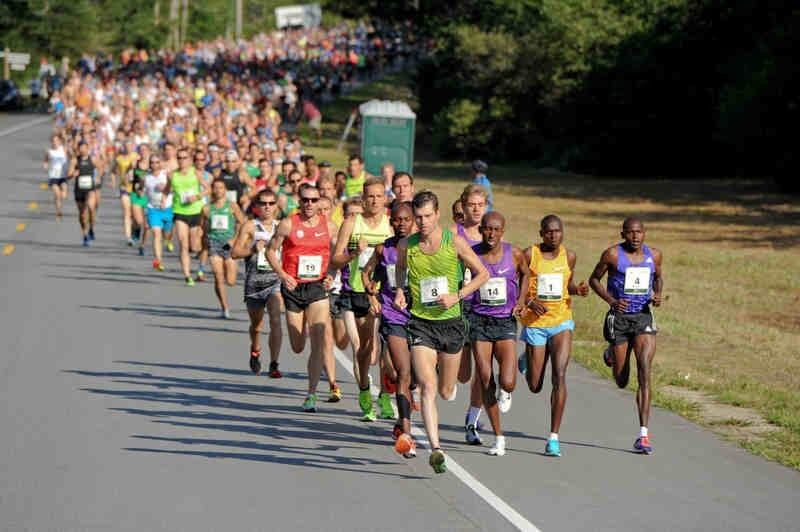
Each year, the scenic race held in Cape Elizabeth needs about 800 volunteers to make it happen.
People from all over New England and throughout the world come to Maine for the race. It begins on Route 77 near the entrance of Crescent Beach State Park, winds along tree-lined streets and past breathtaking ocean vistas, and ends in Fort Williams Park at historic Portland Head Light, the most photographed lighthouse in the world.

Thousands of spectators cheer runners along the route and at the finish. In 2021, more than 2,000 runners participated in the race’s only virtual TD Beach to Beacon 10K.
The popular annual race debuted in 1998 with 2,408 runners crossing the finish line.
More than $90,000 in prize money is awarded to the top finishers and place winners in various categories for men and women, and a separate $30,000 donation is provided to a designated beneficiary each year by TD Bank. This year's beneficiary is Valo Maine, a nonprofit that helps Maine teens with their mental well-being.
The iconic event is managed by DMSE Sports of Woburn, Massachusetts. Along with the TD Beach to Beacon 10K, DMSE assists the Boston Athletic Association with managing the Boston Marathon and other high-profile sports events.
(07/15/23) Views: 88Hannah Yechivi
Cardboard beds for athletes to return at Paris 2024 Olympics
The infamous beds are back! 16,000 cardboard beds will be supplied for all Olympic and Paralympic athletes plus media.
The cardboard beds that went viral from the Tokyo 2020 Olympics will make a resurgence at the 2024 Games in Paris. The 2024 Olympic organizing committee confirmed that they have selected Japanese mattress manufacturer Airweave, which will supply an impressive tally of 16,000 cardboard beds for all athletes housed in the Olympic and Paralympic Villages, as well as journalists staying at the Media Village.

To relieve any concerns about the size, these beds come in a standard dimension of nearly three feet wide and six and a half feet in length. However, the beds can be extended to 2.20 meters for tall athletic superstars (like seven-foot basketball player Victor Wembanyama of France). After all, we don’t want Olympians’ or Paralympians’ legs dangling off the end of the bed.
You might recall the frenzy on social media surrounding these cardboard beds during the previous Olympics. Some suggested that Tokyo 2020 organizers were being “anti-sex,” as if these beds were specifically engineered to sabotage athletes’ romantic and athletic endeavors. The rumors were swiftly debunked when videos flooded the app TikTok showing Olympic athletes jumping on the beds to test their sturdiness.

Two-time U.S. Olympic 5,000m medalist Paul Chelimo shared his thoughts on the cardboard beds, stating that it likely wouldn’t be a problem for distance runners, and how they could probably fit four of them.
Motokuni Takaoka, the esteemed founder of Airweave, joined the athletes in this whimsical testing routine. He gleefully jumped on the beds himself to demonstrate their durability, exclaiming, “We have designed these cardboard beds for three or four people jumping because after winning a medal, athletes get very happy!” Who can argue with that?
Paris 2024 president Tony Estanguet expressed his satisfaction with Airweave’s beds, praising their use of recycled materials in line with the organizing committee’s sustainability aspirations. “We were impressed by Airweave’s technology,” he said in a press release. “We know that we have a solid partner in terms of sustainability and delivery.”
When cardboard beds reach the end of their useful life at the Olympics, they are broken down and recycled. Unlike other materials that may contribute to landfill waste, cardboard is biodegradable, making them an easy eco-friendly choice to promote a greener Olympic Games.
(07/17/23) Views: 87Running Magazine
2023 Hardrock 100 Women’s Race
If it wasn’t for Courtney Dauwalter (pre-race interview) running the Western States 100 just three weeks prior, crushing the women’s record there, and potentially being a bit worn out at the start line of the Hardrock 100, it would have been hard to find someone to bet against her winning the race this year. But if she were to falter, there were several women who were ready to jump at the opportunity.
For the first part of the race, it seemed like France’s Anne-Lise Rousset Séguret was going to do just that. While Dauwalter led in the very early miles of the course, Rousset opened up a sizable gap coming through Maggie Gulch at mile 15.5 and was moving with enthusiasm toward Pole Creek, the next aid station. She came into Sherman at mile 30 in seventh overall in 6:29, looking strong. Dauwalter was just six minutes behind, and Annie Hughes (pre-race interview) came in next, 52 minutes off the lead. With still many miles to run, it was still anyone’s race. Frenchwoman Claire Bannwarth (pre-race interview) came through just seven minutes later and was followed by Japan’s Kimino Miyazaki (pre-race interview), who was 1:22 off the lead but looking spry and happy.
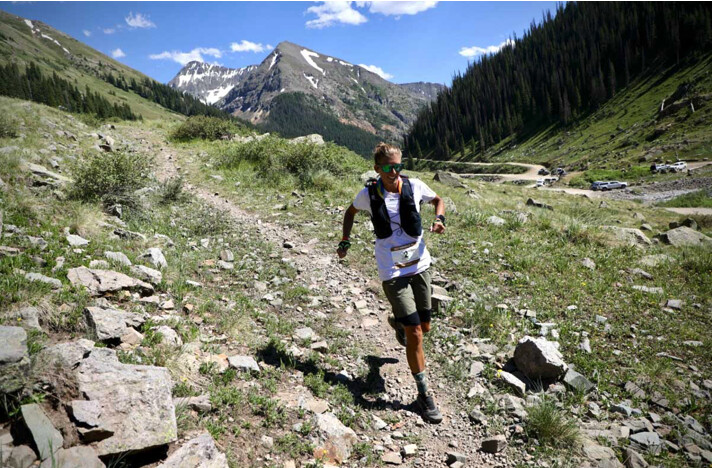
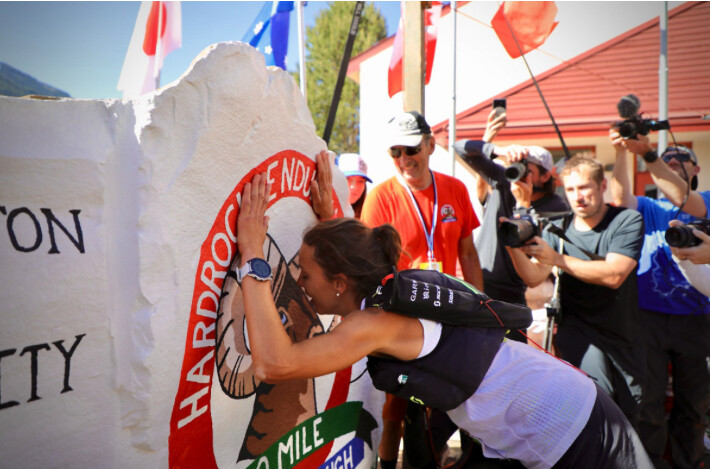
The top-two women came back together through Grizzly Gulch at mile 36 with Hughes trailing them at just under an hour back. When Rousset led Dauwalter into Grouse Gulch, mile 43.5, by nearly 10 minutes after traversing Handies Peak, the course high point, it seemed like maybe the Western States 100-Hardrock 100 double was going to be too much for Dauwalter to handle.
But it’s never a good idea to bet against the most dominant female trail ultrarunner of this generation. By mile 50, she’d closed the gap to four minutes, and in Ouray at mile 58.5, it was down to two minutes. When it came to the climb out of Ouray, Dauwalter made her move, and the elastic to Rousset finally snapped over the top of Virginius Pass. Dauwalter never looked back.
Meanwhile, Hughes stayed steady in third place while dealing with stomach issues and the rest of the women’s pack, including Miyazaki, Bannwarth, Christina Bauer, Whitney Mickelsen, Darla Askew, Becky Bates, and last-minute waitlist entrant Emily Halnon, who only got into the race the morning before, continued to chase — all within close proximity to each other.
Dauwalter ran into Telluride at mile 74.5, her pace still hovering just a few minutes over course-record pace, but now 23 minutes ahead of second-place Rousset, and executed the fasted crew stop of the Telluride aid station, getting in and out in under three minutes. She was on a mission.
Just 10 miles later, she was well below course-record pace, crushing the Bear Creek Trail climb out of Telluride and moving herself into third overall as some of the lead men began to falter. Rousset also continued her relentless march, and while she was 48 minutes back on Dauwalter at mile 84, she was only three minutes up on course-record pace.
In the end, there was no catching Dauwalter as she ran back to Silverton to kiss the rock with a new women’s counterclockwise course record of 26:14:08, besting the one set by the legendary Diana Finkel in 2009, and finishing fourth overall. She also set a new overall women’s record, beating her old time of 26:44:36, which she set last year.
Not only that, she set a new overall record for the Western States 100-Hardrock 100 double with a combined time of 41:43:42, beating Jeff Browning’s old record of 42:12:43 that he set in 2016.
Rousset would finish second after a gutsy run with a time of 27:29:55, which registers as the fifth-fastest time in event history, and Hughes would hold onto third with a time of 32:13:03 after spending nearly 100 miles battling stomach and breathing issues.With large gaps between the first, second, and third women, all eyes turned to the competition between fourth and 10th where the time gaps were tight and the women were often in the aid stations together in the back half of the race. Miyazaki and Bannwarth ran in close proximity to each other battling for fourth and fifth, while Mickelsen, Halnon, Bates, Askew, and Bauer seemed to maintain the same overall pace as the miles ticked by.
(07/16/23) Views: 86Eszter Horanyi -I run far
Utah’s Clayton Young won the Crazy 8s 8K title on Saturday night
Utah’s Clayton Young bided his time until the last moment and made a strong move to win Saturday’s 33rd Ballad Health and Niswonger Children’s Hospital Crazy 8s 8-kilometer run on the candle-lit streets of the Model City.
With 200 meters to go, Young — the 2019 NCAA 10,000-meter champion from BYU — broke away from a group of six runners as he made his way into J. Fred Johnson Stadium to claim his second USATF title in 22:46 and the $5,000 that went along with the win.

There were nearly 3,200 finishers in Saturday’s races, including the Almost Crazy 3K, which was up almost 300 from last year.
“I was talking with my teammate Conner Mantz, who was runner-up last year and he said when he made his move, he felt like it wasn’t strong enough,” Young said. “He told me that I should be making that move before I turn up the hill. When I made my move, I was thinking about him and how he coached me through those final stages.”
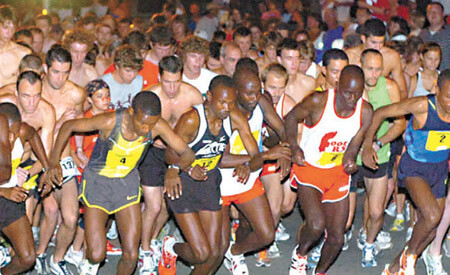
Alberto Salazar’s American record of 22:04 lived another day. The start of the race was delayed by 45 minutes because of a strong thunderstorm that swept through the area.
“I had a lot of confidence going into this race,” Young said. “I’ve trained with Conner a lot and he’s had a great season, so that was a pretty good indicator. I just rode his coattails and went out there to see what I could do today.”
ZAP Endurance runner Andrew Colley was runner-up, finishing in 22:48. Oklahoma State graduate Isai Rodriguez took out the pace early and finished third in 22:49.
Young — who won the 2021 USATF 15K title in Jacksonville, Florida — trains with Mantz and now he’s got one up on his former BYU teammate.
“It’s finally nice to win another U.S. championship,” Young said. “You’ve got to celebrate all the victories, no matter how big or small they are. They keep you going and keep you motivated.
“To feel that strength over the last 800 meters was really validating and hopefully it’ll propel me through these next couple of races and into a fall marathon.”
Kingsport native Emma Russum — a member of Dobyns-Bennett’s 2019 state cross country state title team who now runs for Chattanooga — won the women’s division in 31:02.
It’s a dream come true of sorts for Russum, who’s regularly run the race since she was 6 years old.
“It feels really good to win and it’s even better because I got second last year,” Russum said. “I ran 20 seconds slower than last year, but it was super fun and I definitely was trying to keep a more relaxed effort at the beginning.
“People were yelling at me in the last bit that a girl was coming, so I had to kick it in. I love this race and I’ve been running it since I was big enough to run in (Little 8s).”
Russum made a little bit of area history as well, becoming the third local female runner to win the Crazy 8s title. She joined Johnson City’s Jenna Hutchins and Bristol, Virginia’s Stephanie Place.
“It’s really cool to be a part of such a short history of local winners,” Russum said.
(07/17/23) Views: 86Tanner Cook
Stephanie Bruce on running while pregnant: “It doesn’t have to make sense to everyone”
"This is a gift–to be out doing what I love while growing a baby," Bruce says.
American marathoner Stephanie Bruce is not letting pregnancy slow her down. In May, 18 weeks into her third pregnancy, Bruce was the top female finisher at the Big Sur 12K in 45:41, coming in second overall, only a minute behind first place.
Known for her upfront talk about post-pregnancy running after the birth of her other two children, Bruce has been sharing social media updates chronicling the joys and challenges of running (and racing) while pregnant, noting, “It doesn’t have to make sense to everyone.”

Bruce has had a prolific career in cross-country, representing the U.S. twice at the World Cross Country Championships, in 2017 and 2019. Bruce was the second American behind Emma Bates at the 2019 Chicago Marathon, where she ran her personal best time of 2:27:47, and she had a 10th place finish at the NYC Marathon in November (2:31:05). She has spent the last decade training with Ben Rosario’s Hoka NAZ Elite team in Flagstaff, Ariz.
In January 2022, Bruce announced she would be retiring at the end of the season, after she was diagnosed with a congenital heart condition called bicuspid aortic valve disease (BAVD), a dysfunction of the aorta valve limiting the amount of blood flowing from your heart to the body.

A few months later, in what she called “the pivot,” she changed her mind, sharing on her blog that “after a period of deep reflection–now I have had a change of heart. I am not ready to hang up my racing shoes.”
A few months later, Bruce announced her pregnancy. The athlete plans to return to racing competitively after her baby is born and has been documenting her journey to inspire others. Bruce says still she can still run reps between a 3:00 and 3:30 min/km pace, but is finding turning over in bed is becoming difficult. In her third trimester, she says that she misses competing.
Bruce explains her goal in sharing her pregnant running experience: “To show women our bodies can handle it, if we choose, not everyone and that’s ok if we stay on the couch and don’t feel motivated. Every pregnancy experience is different and I am simply sharing how mine is playing out.”
Bruce recently published a book, written with Rosario, titled Follow Your Heart, The Story of Stephanie Bruce’s Not-So-Final Season.
(07/17/23) Views: 82Keeley Milne





